Automated Guided Vehicles Market Size
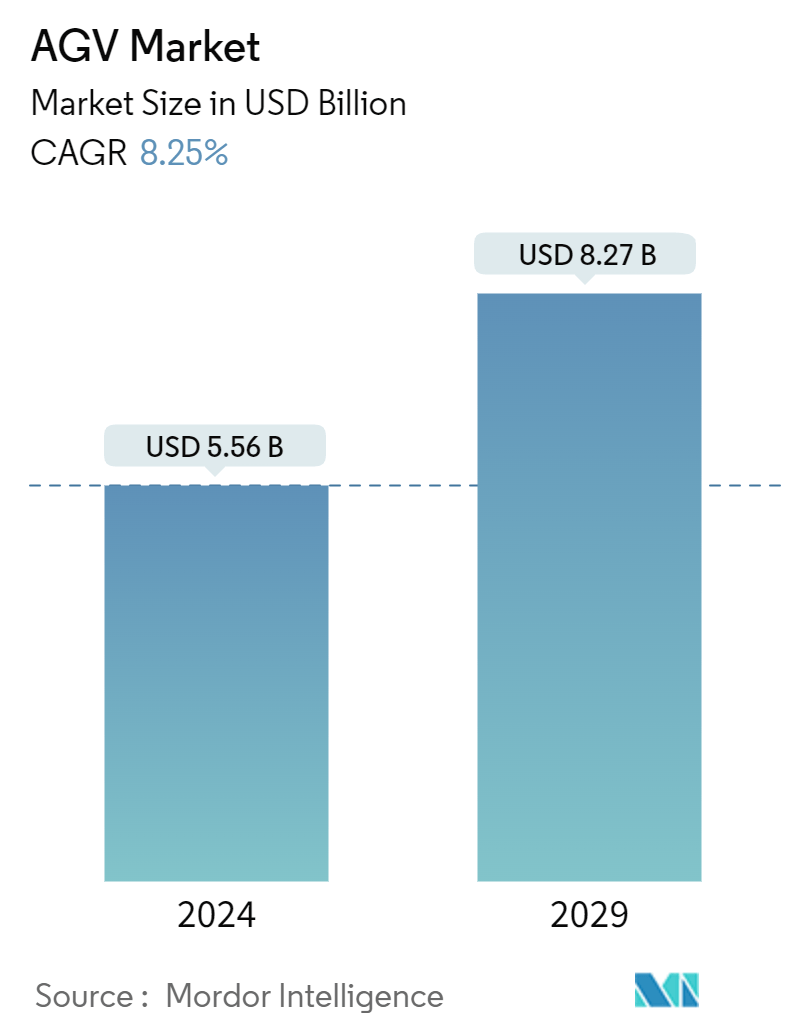
| Study Period | 2019 - 2029 |
| Market Size (2024) | USD 5.56 Billion |
| Market Size (2029) | USD 8.27 Billion |
| CAGR (2024 - 2029) | 8.25 % |
| Fastest Growing Market | Asia Pacific |
| Largest Market | North America |
Major Players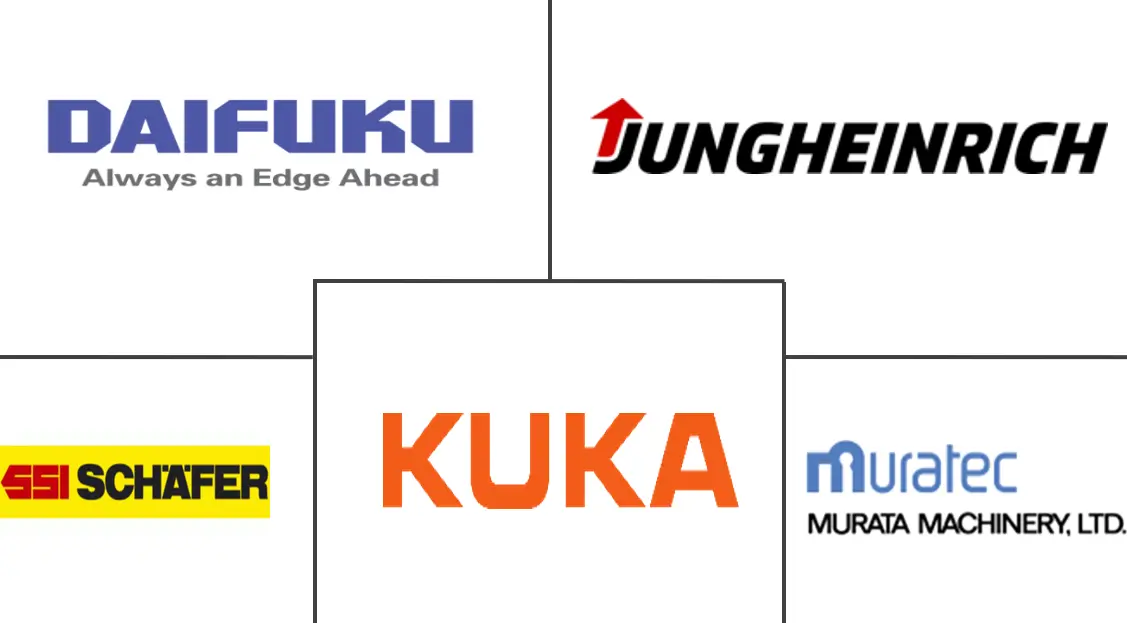
*Disclaimer: Major Players sorted in no particular order |
Automated Guided Vehicles Market Analysis
The AGV Market size is estimated at USD 5.56 billion in 2024, and is expected to reach USD 8.27 billion by 2029, growing at a CAGR of 8.25% during the forecast period (2024-2029).
- Rising technological advancements, increased demand for automation in industries, increased demand for robots in manufacturing and warehousing facilities, and growing emerging markets are the key factors driving the growth of the automated guided vehicles market.
- In recent years, automation has revolutionized the manufacturing sector, resulting in enhanced productivity, efficiency, and safety. Among the latest breakthroughs in automation technology are automated guided vehicles (AGVs). AGVs have gained considerable recognition in manufacturing facilities due to their ability to ensure human safety and meet the demand for optimal efficiency. Technological advancements have empowered manufacturers to create AGVs tailored to their operational requirements and effectively implement them for various applications.
- The automotive industry is increasingly incorporating automation and AGVs into its manufacturing floors. For instance, the SEAT plant in Martorell, Spain, is transforming into a digitalized and smart factory. The company implemented AGVs with SLAM navigation, 4G connectivity, and induction battery charging. The facility has eight AGVs for outdoor operation and over 200 AGVs that deliver parts inside the assembly workshops at the Martorell and Barcelona factories.
- The global labor market is extremely tight, which is the primary reason for the growth of automated forklifts. Despite the fact that unemployment is at its lowest level in fifty years, distribution centers and warehouses find it difficult to find and keep trustworthy workers. Automation could provide continuous, reliable performance around the clock, helping to close the labor gap.
- Furthermore, several vendors in the market are focusing on launching AGVs for parking in the buildings, further supporting the market’s growth. For instance, in April 2024, Autech-Otis Parking Systems launched an automatic guided vehicle (AGV) parking robot utilizing artificial intelligence (AI) technology. It is an autonomous driving system that combines AI and Internet of Things (IoT) technologies. Its goal is to automatically find the best routes for self-driving parking lots so that unmanned parking can be made easier.
- The continuously increasing R&D expenditure and the rising number of production establishments worldwide are driving the demand for automation worldwide in mid-range industries, especially in the food processing and pharmaceutical sectors.
- Moreover, companies that automate their supply chains or manufacturing processes with AGVs have to invest a lot of money. This takes care of the price of buying, setting up, and adjusting the workspace to make it more AGV-friendly. Moreover, manufacturers might be dissuaded from using AGVs due to their high cost. Smaller businesses may find it difficult to adopt AGVs since they cannot afford automated systems and must instead use traditional, manual forklift trucks.
- Furthermore, other threats such as recession, inflation, war, climate change, trade disputes, energy access, and industrial espionage are some of the factors that are responsible for directly shaping the role of AGVs in end-user sectors.
Automated Guided Vehicles Market Trends
Rapid Growth of E-commerce Demanding Higher Efficency
- Despite growth in the manufacturing industry, considerable demand from the warehousing and logistics sector is dedicated to e-commerce activity. For instance, the Canadian warehouse portfolio is mainly comprised of e-commerce, which is estimated to make up more than 50% of the country's warehouse business.
- The deployment of AGVs provides an opportunity for different areas in e-commerce. Specifically, the AGVs are suited for fulfillment operations involving large quantities of small orders for large SKU ranges spread across large warehouse areas. Using autonomous robots to perform horizontal traveling can increase order fulfillment efficiency.
- With the introduction of always-on e-commerce, the demand for faster responses, and the need to manage a more significant number of stock-keeping units with fewer errors, warehouses need to scale up and meet the standards of an intelligent, efficient, and automated warehouse. Such increasing globalization and the rise of online retail and bulk retail have increased demand for AGVs in the retail industry.
- The rising demand for e-commerce companies to cater to the increasing number of single-day delivery orders, both in advanced and emerging economies, has resulted in a significant increase in efficiency owing to the commercial viability of these schemes. E-commerce warehouses carry out the single-day delivery method with the aid of AGVs.
- The growth in the e-commerce industry, along with the need for efficient warehousing and inventory management across the world, are driving the market studied. For instance, according to the Census Bureau of the Department of Commerce, in the fourth quarter of 2023, the share of e-commerce in total US retail sales stood at 15.6%, up from the previous quarter. From October to December 2023, retail e-commerce sales in the United States hit over USD 285 billion, the highest quarterly revenue in history.
- The rapidly changing retail market compels distribution centers to seek out and implement innovative, flexible, and automated approaches to e-commerce order fulfillment. Such a rise in e-commerce purchases is expected to push companies to deploy automated material handling equipment in their operation process to enhance smooth workflow.
- Moreover, supply chains began using AGVs in distribution centers in response to increased e-commerce demand, allowing industries to function at high productivity. AGVs' use has expanded in sectors like pharmaceuticals to keep up with demand and maintain sanitation. Hospitals and other healthcare facilities utilize AGVs to undertake the contactless transfer of food, trash bins, linens, and sterile supplies.
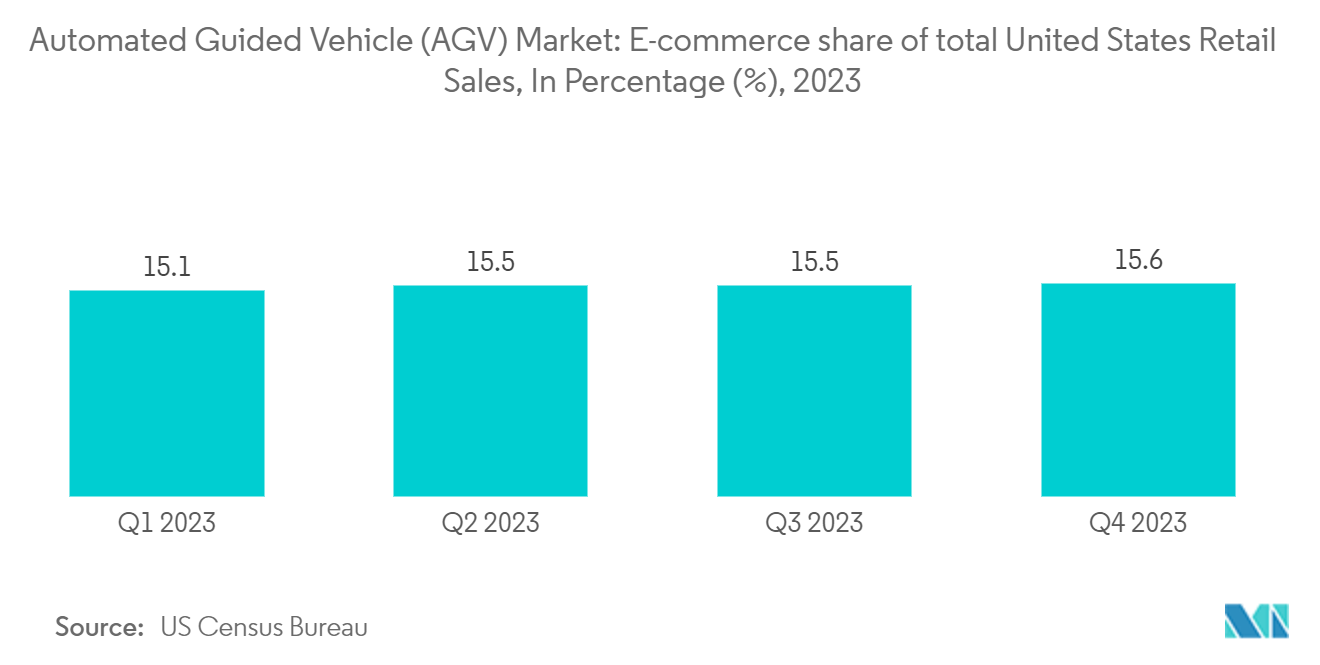
Asia-Pacific Expected to Witness Significant Growth
- The AGV market in China is primarily driven by the country's proliferating manufacturing industry. China has the largest manufacturing industry in the world, and it is also a key contributor to the country's economic growth.
- China is anticipated to be a crucial market for automated guided vehicles, given the expanding retail sector and increased investments. Rising consumption rates and the growing demand for larger warehouses are also driving the need for AGVs.
- Moreover, China is a major adopter of Industry 4.0, and the region is home to some of the most advanced manufacturing facilities in the world, ahead of regions like the European Union, the United States, and Japan.
- According to the World Economic Forum, of the 69 factories around the world now considered leaders using Industry 4.0 technologies, China is now home to 20, followed by 19 in the European Union, 7 in the United States, and 5 in Japan. Besides being the foundation for plant-wide automation, the automated storage and retrieval system also serves as a foundation for Industry 4.0.
- Moreover, with the increasing demand for e-commerce in emerging countries, such as India, China, and neighboring countries, e-commerce companies have been deploying AGVs at warehouses significantly. According to the IBEF, Indian e-commerce is projected to witness a CAGR of 27% to reach USD 163 billion by 2026. Similarly, in FY23, the gross merchandise value (GMV) of e-commerce in India reached USD 60 billion, increasing 22% over the previous year.
- In addition, several companies are adopting AGVs to support automation in the business, further driving the market. For instance, in April 2024, Busan Newport's Dongwon Global Terminal (DGT) held its formal inauguration ceremony. This was a significant milestone in Korea's port automation journey, as the terminal is the first in the country to use AGVs for horizontal transportation. At Busan Newport, DGT is the seventh container terminal. Automated yard cranes, also known as "transfer cranes," are present in all six of the other terminals at Busan New Port. However, DGT is the first to use AGVs.
- Similarly, in August 2023, Westports Malaysia announced plans to investigate the potential of using electric automated guided vehicles in future terminal development plans.
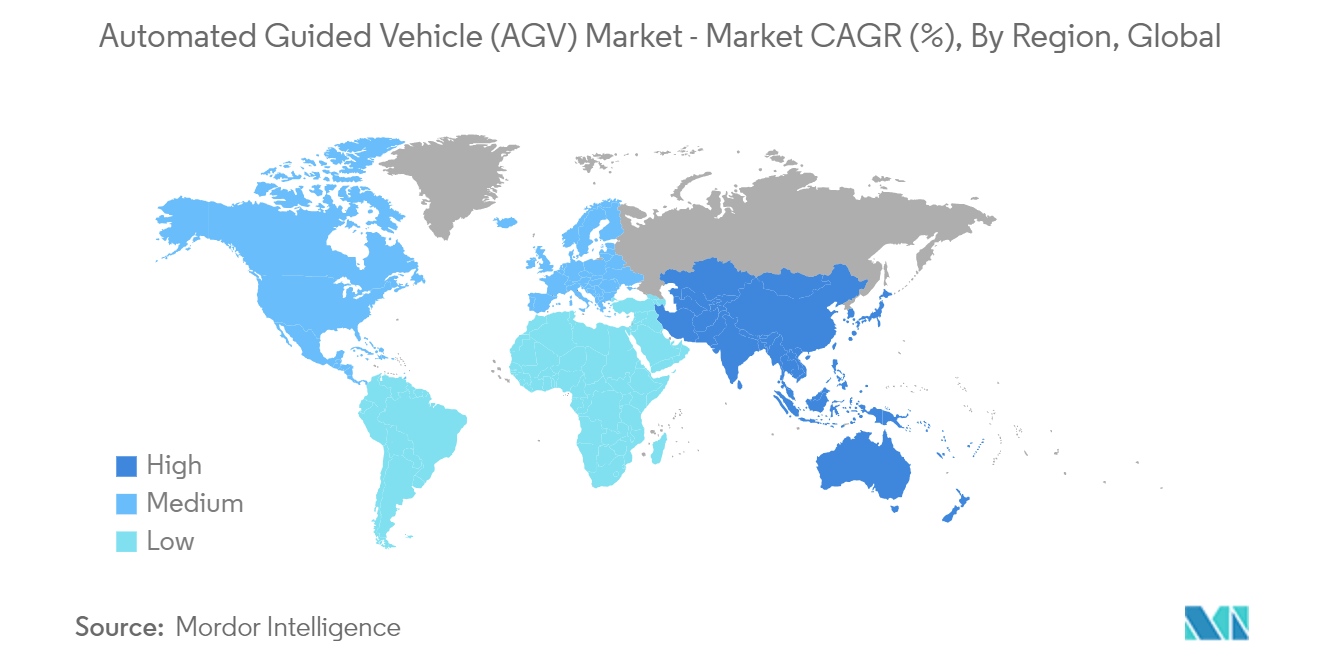
Automated Guided Vehicle Industry Overview
The global automated guided vehicle market is fragmented, with numerous players vying for market share. The industry is witnessing significant growth opportunities, driven by factors like digital transformation and the integration of Industry 4.0 with IoT. Leading the pack are prominent players, including Kuka AG, Daifuku Co. Ltd, SSI Schaefer AG, Murata Machinery Ltd, and Jungheinrich AG.
- March 2024: FFT announced the expansion of its portfolio with a new automated guided vehicle system by partnering with inductive charging tech provider Wiferion, which automaker BMW is now using. The charging systems from FFTigv and Wiferion have been implemented at the BMW Group plant in Leipzig. FFT created a new manufacturing facility, thereby utilizing wireless charging and AGVs to increase output and efficiency.
- March 2024: Cypher Robotics announced the release of the Captis Autonomous Ground Vehicle (AGV) for efficient and accurate cycle counting and industrial scanning. The Captis AGV is capable of navigating warehouses by itself. It does not require any changes to the infrastructure and will not collide with people or objects.
Automated Guided Vehicle Market Leaders
-
KUKA AG
-
Jungheinrich AG
-
Murata Machinery Ltd
-
Daifuku Co. Ltd
-
SSI Schaefer AG
*Disclaimer: Major Players sorted in no particular order
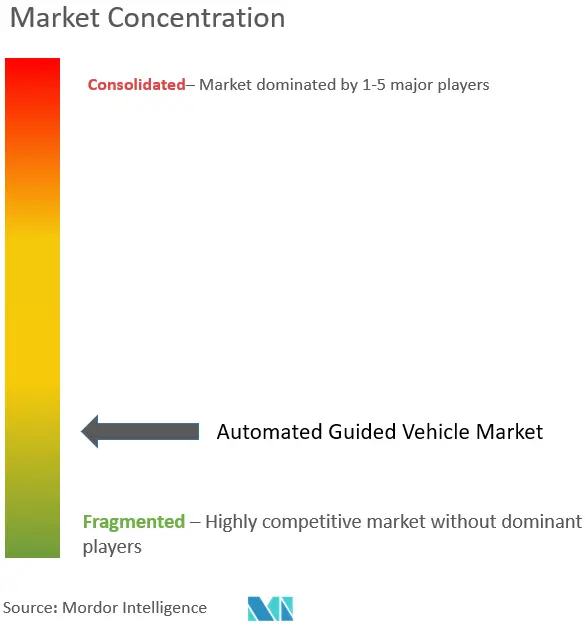
Automated Guided Vehicle Market News
- December 2023: ARAPL announced a strategic collaboration with its subsidiary ARAPL RaaS to develop India’s first mobile robotic multi-level car parking system using automated guided vehicles.
- September 2023: Jungheinrich and Mitsubishi Logisnext Americas announced the launch of Rocrich AGV Solutions (Rocrich). Rocrich offers a comprehensive suite of mobile automation and robotics solutions, leveraging global industry expertise. The joint venture combines innovative solutions with the industry’s best service promise, with operations starting in Houston, TX.
AGV Market Report - Table of Contents
1. INTRODUCTION
- 1.1 Study Assumptions and Market Definition
- 1.2 Scope of the Study
2. RESEARCH METHODOLOGY
3. EXECUTIVE SUMMARY
4. MARKET INSIGHTS
- 4.1 Market Overview
- 4.2 Industry Value Chain Analysis
-
4.3 Industry Attractiveness - Porter's Five Forces Analysis
- 4.3.1 Bargaining Power of Suppliers
- 4.3.2 Bargaining Power of Buyers/Consumers
- 4.3.3 Threat of New Entrants
- 4.3.4 Threat of Substitute Products
- 4.3.5 Intensity of Competitive Rivalry
- 4.4 Impact of COVID-19 Aftereffects and Other Macroeconomic Factors on the Market
5. MARKET DYNAMICS
-
5.1 Market Drivers
- 5.1.1 Rapid Growth of E-commerce Demanding Higher Efficiency
- 5.1.2 Increasing Investments in Technology and Robotics
-
5.2 Market Restraints
- 5.2.1 Limitation of Real-Time Wireless Control Due to Communication Delays
6. MARKET SEGMENTATION
-
6.1 By Product Type
- 6.1.1 Automated Fork Lift
- 6.1.2 Automated Tow/Tractor/Tugs
- 6.1.3 Unit Load
- 6.1.4 Assembly Line
- 6.1.5 Special Purpose
-
6.2 By End-User Industry
- 6.2.1 Food & Beverage
- 6.2.2 Automotive
- 6.2.3 Retail
- 6.2.4 Electronics & Electrical
- 6.2.5 General Manufacturing
- 6.2.6 Pharmaceuticals
- 6.2.7 Other End User Industries
-
6.3 By Geography***
- 6.3.1 North America
- 6.3.2 Europe
- 6.3.3 Asia
- 6.3.4 Australia and New Zealand
- 6.3.5 Latin America
- 6.3.6 Middle East and Africa
7. COMPETITIVE LANDSCAPE
-
7.1 Company Profiles*
- 7.1.1 KUKA AG
- 7.1.2 Jungheinrich AG
- 7.1.3 Murata Machinery Ltd
- 7.1.4 Daifuku Co. Ltd
- 7.1.5 SSI Schaefer Systems International DWC LLC
- 7.1.6 Swisslog Holding
- 7.1.7 Dematic Corp.
- 7.1.8 Toyota Material Handling
- 7.1.9 Scott Technology Limited
- 7.1.10 John Bean Technologies (JBT) Corporation
- 7.1.11 Systems Logistics SPA
- 7.1.12 Seegrid Corporation
8. INVESTMENT ANALYSIS
9. FUTURE OF THE MARKET
** Subject To AvailablityAutomated Guided Vehicles Industry Overview
Automated guided vehicles (AGVs) are wholly automated transport systems that operate with unmanned vehicles. They offer many advantages, such as reduced operational costs, enhanced workforce safety, and decreased production time. The growing execution of mobile robots worldwide and measures to improve workplace safety and productivity are other factors leading to the adoption of AGVs.
The automated guided vehicle market is segmented by product type (automated forklift, automated tow/tractor/tugs, unit load, assembly line, and special purpose), end-user industry (food & beverage, automotive, retail, electronics & electrical, general manufacturing, pharmaceuticals, and other end-user industries), and geography (North America, Europe, Asia-Pacific, Latin America, and Middle East and Africa). The market sizes and forecasts are provided in terms of value (USD) for all the above segments.
| By Product Type | Automated Fork Lift |
| Automated Tow/Tractor/Tugs | |
| Unit Load | |
| Assembly Line | |
| Special Purpose | |
| By End-User Industry | Food & Beverage |
| Automotive | |
| Retail | |
| Electronics & Electrical | |
| General Manufacturing | |
| Pharmaceuticals | |
| Other End User Industries | |
| By Geography*** | North America |
| Europe | |
| Asia | |
| Australia and New Zealand | |
| Latin America | |
| Middle East and Africa |
AGV Market Research Faqs
How big is the AGV Market?
The AGV Market size is expected to reach USD 5.56 billion in 2024 and grow at a CAGR of 8.25% to reach USD 8.27 billion by 2029.
What is the current AGV Market size?
In 2024, the AGV Market size is expected to reach USD 5.56 billion.
Who are the key players in AGV Market?
KUKA AG, Jungheinrich AG, Murata Machinery Ltd, Daifuku Co. Ltd and SSI Schaefer AG are the major companies operating in the AGV Market.
Which is the fastest growing region in AGV Market?
Asia Pacific is estimated to grow at the highest CAGR over the forecast period (2024-2029).
Which region has the biggest share in AGV Market?
In 2024, the North America accounts for the largest market share in AGV Market.
What years does this AGV Market cover, and what was the market size in 2023?
In 2023, the AGV Market size was estimated at USD 5.10 billion. The report covers the AGV Market historical market size for years: 2019, 2020, 2021, 2022 and 2023. The report also forecasts the AGV Market size for years: 2024, 2025, 2026, 2027, 2028 and 2029.
AGV Industry Report
The Automated Guided Vehicle (AGV) Market Report provides a comprehensive market overview and market analysis, segmented by product type and end-user industry. The market segmentation includes automated forklift, automated tow/tractor/tugs, unit load, assembly line, and special purpose AGVs. The end-user industries covered are food & beverage, automotive, retail, electronics & electrical, general manufacturing, pharmaceuticals, and other end-user industries.
The report includes valuable industry information and industry trends, offering insights into the market size and market share. The industry analysis highlights the market growth and market forecast, providing an industry outlook and market predictions. The report also features industry statistics and industry sales data, giving a detailed market review and market value assessment.
Geographically, the AGV market is analyzed across North America, Europe, Asia-Pacific, Latin America, and the Middle East and Africa. The market report includes a report example and is available as a free report PDF download. The industry research includes market leaders and research companies, ensuring a thorough understanding of the market dynamics.
The AGV market report is an essential tool for understanding market data and market trends, with a focus on growth rate and market outlook. The industry reports and market overview provided are crucial for stakeholders looking to make informed decisions in the AGV market.



